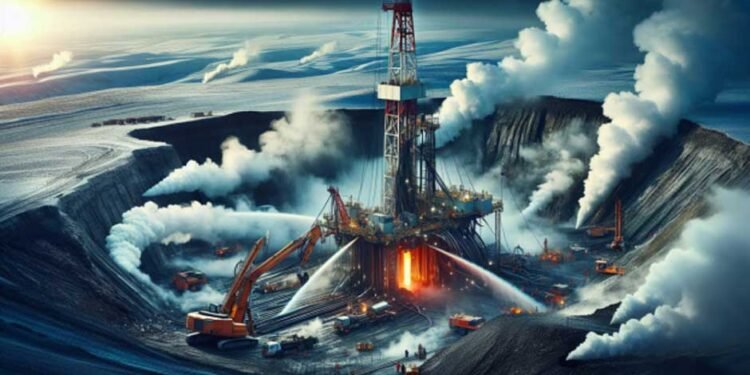Introduction to Geothermal Drilling
Definition and Importance of Geothermal Drilling
Geothermal drilling is a complex process that involves penetrating the Earth’s surface to access geothermal energy reserves. These reserves are harnessed to generate clean, renewable energy, which is a crucial alternative to fossil fuels. Geothermal drilling taps into the Earth’s internal heat, which is conveyed to the surface via water or steam and can be utilized to produce electricity or for direct heating purposes. This form of energy extraction is significantly important because of its low carbon footprint and its capability to provide baseload power, which means it is consistently available regardless of weather conditions, unlike solar or wind energy.
Overview of Geothermal Energy
Geothermal energy comes from the heat stored beneath the Earth’s crust. It is a sustainable resource that offers a lower environmental impact compared to conventional energy sources. The core of the Earth is brimming with heat, with the crust absorbing some of this heat. In certain regions, naturally occurring geological processes bring this heat closer to the surface, making it accessible through drilling. Geothermal plants can operate 24/7, providing a steady and reliable source of energy. Besides electricity generation, geothermal energy can also be directly used for heating buildings, greenhouses, and in industrial processes, showcasing its versatility.
The Evolution of Geothermal Drilling Equipment
History and Progress of Drilling Technologies
Over the years, geothermal drilling equipment has undergone remarkable transformation. Initially, the equipment used was quite similar to that used in the oil and gas industry. However, the distinct challenges of geothermal drilling, such as higher temperatures and corrosive environments, demanded specialized adaptations. As the industry advanced, equipment evolved to become more durable, efficient, and capable of reaching greater depths. The progression was spurred by engineering breakthroughs in materials science, computer-aided design technologies, and robust machinery that could withstand the hostile geothermal environments.
Comparison with Traditional Drilling Equipment
Compared to traditional drilling equipment used in the oil and gas sector, geothermal drilling equipment is designed to cater to the uniqueness of geothermal reservoirs. These reservoirs can present extreme conditions, including high temperatures and pressures, along with the presence of corrosive fluids. Geothermal drilling rigs must also account for the brittleness of certain rock types encountered during operations. As a result, manufacturers have developed drilling rigs and components that can endure these demanding conditions while maintaining operational efficiency and safety standards.
Key Components of Modern Geothermal Drilling Rigs
Drill Bits: Types and Materials
Drill bits are critical components of geothermal drilling equipment as they are the primary tools for crushing and penetrating the rock. The type and material of the drill bit chosen for a geothermal drilling project depend on the formation’s properties. The most common types include roller cone bits, which are preferred for their ruggedness in hard rock formations, and polycrystalline diamond compact (PDC) bits that are favored for their wear-resistance and ability to drill longer sections. Materials used in drill bit construction have also seen innovations, with the use of harder and more heat-resistant materials becoming commonplace.
Drill Pipes and Casings
Drill pipes and casings are the structural elements of the drilling rig, providing the necessary support for drilling operations. Drill pipes must withstand extreme torque and axial loads during drilling, while casings protect well integrity, preventing contamination of groundwater and averting the collapse of unstable rock formations. Modern drill pipes and casings are fabricated from advanced steel alloys and composites, designed to exhibit high strength and resilience against the aggressive drilling environment encountered in geothermal wells.
Enhancing Drilling Efficiency with Automation
Automated Drilling Systems
Automation technologies have been a game-changer for geothermal drilling equipment. Automated drilling systems leverage computer algorithms and robotics to enhance precision, speed, and safety. These systems can automatically adjust drilling parameters in response to changing rock conditions, improving the efficiency of drilling operations. They also reduce the need for hands-on intervention, which can be especially beneficial in hazardous environments.
Benefits of Automation in Geothermal Drilling
The incorporation of automation in geothermal drilling brings multiple benefits. It leads to better control of the drilling process, minimizing the potential for human error and enhancing overall site safety. Automation can also optimize the drilling process, reducing time and costs. In addition, it minimizes the wear on equipment, extending the lifespan of critical components and reducing downtime for maintenance.
High-Pressure Drilling Fluid Systems
Composition and Functions of Drilling Fluids
High-pressure drilling fluid systems are a vital aspect of geothermal drilling equipment. These fluids, which are carefully engineered to suit specific drilling conditions, perform several functions. They cool and lubricate the drill bit, carry rock cuttings to the surface, prevent well collapse by stabilizing the wellbore, and control subsurface pressures. The fluids are typically a mix of water, additives, and other substances formulated to optimize the performance across various geothermal drilling scenarios.
Innovations in Fluid Circulation Systems
The circulation systems that deliver these drilling fluids to the drill bit and back to the surface have also experienced significant innovation. Enhanced pump designs and materials can handle the high temperatures and abrasive particles, ensuring the continuous movement of fluids. Innovations include the introduction of higher-capacity pumps and advanced circulation techniques that improve the removal of cuttings and ensure the durability of the pump system under rugged drilling conditions.
Advanced Monitoring and Control Systems
Real-Time Data Acquisition
Advancements in monitoring and control systems have propelled geothermal drilling into a new age of operational intelligence. Real-time data acquisition systems gather information on various parameters like temperature, pressure, vibration, and bit wear, offering an instantaneous view of the drilling operation’s status. This data is crucial for making informed decisions on the fly, optimizing drilling strategies, and preventing costly mistakes or accidents.
Role of Remote Monitoring in Operations
Remote monitoring allows geothermal drilling operations to be supervised from a distance, enhancing the flexibility and safety of drill site management. Technicians can analyze data and make adjustments without being physically present at the rig, providing an added layer of security and reducing the risk of accidents. This capability is particularly valuable in remote or difficult-to-access locations and reduces the environmental impact by requiring fewer personnel onsite.
Thermal Resistant Materials and Technologies
Development of Heat-Resistant Alloys
Geothermal wells can reach temperatures that would prematurely wear or damage traditional materials. The development of heat-resistant alloys for use in geothermal drilling equipment has been crucial to overcome this challenge. These specialized alloys retain their strength and integrity at elevated temperatures, allowing for deeper and more efficient drilling into geothermal reserves.
Application in High-Temperature Wells
The application of these heat-resistant alloys is evident in the components that are directly exposed to high temperatures, such as drill bits, downhole tools, and even the rig itself. They must be able to withstand not just high temperatures but also the mechanical stresses and potential corrosion brought about by the geothermal fluids. These materials have extended the life of equipment, reduced operational costs, and unlocked previously inaccessible renewable energy resources.
Addressing Environmental Challenges
Emission Reduction Techniques
While geothermal energy is a cleaner alternative to fossil fuels, the drilling process can still pose environmental challenges. Emission reduction techniques are therefore critical to minimize these impacts. This includes practices like capturing drilling emissions, using cleaner-burning engines, and optimizing drilling processes to reduce fuel consumption. Manufacturers of geothermal drilling equipment are also developing systems that decrease the carbon footprint of drilling operations.
Minimizing the Environmental Footprint
Besides emissions, the physical footprint of drilling operations is a concern. Efforts to reduce the environmental impact include reusing drilling materials, employing closed-loop systems for drilling fluids, and adopting practices that reduce land disturbance. Effective waste management and water conservation strategies further contribute to environmentally responsible geothermal drilling operations.
Case Studies: Successful Geothermal Drilling Projects
The Use of Cutting-Edge Equipment in Practice
Across the globe, several successful geothermal drilling projects highlight the use of cutting-edge geothermal drilling equipment. Projects in geothermally active regions like Iceland, the Philippines, and New Zealand have benefitted from advanced drilling rigs, experiencing increased efficiency and reduced environmental impact. For instance, using high-performance drill bits and automated drilling systems has allowed operators to access deeper, hotter geothermal reservoirs previously thought uneconomical or technologically unfeasible.
Lessons Learned and Key Takeaways
The success of these projects offers valuable lessons, such as the importance of site-specific equipment customization, proactive monitoring and maintenance, and the integration of environmental conservation methods from project inception. Key takeaways further emphasize the need for continued research and development in geothermal technologies and the advantages of international collaboration in sharing best practices and innovations.
The Future of Geothermal Drilling Equipment
Emerging Technologies and Innovations
Looking ahead, the future of geothermal drilling equipment is brimming with potential, driven by emerging technologies and innovations. Breakthroughs in materials science, data analytics, and machine learning are expected to yield equipment that is more reliable, efficient, and adaptable to various geothermal formations. The trend towards automation and remote operation is set to continue, with sophisticated control systems becoming standard.
Prospects for Enhanced Geothermal Systems (EGS)
Enhanced Geothermal Systems (EGS) are a particularly exciting frontier for geothermal drilling equipment. Unlike traditional geothermal resources, EGS can be engineered in a variety of geological settings by artificially creating permeability where none existed. This method significantly expands the potential for geothermal energy but demands innovative drilling equipment capable of establishing and sustaining these man-made reservoirs. The development of such equipment will be vital for the widespread adoption of EGS technologies.
In conclusion, the progression of geothermal drilling equipment is a testament to the industry’s commitment to innovation, efficiency, and environmental stewardship. With each technological advancement, geothermal energy becomes a more compelling option in the quest for sustainable and reliable sources of energy. The continued evolution of this equipment is essential not just for increasing the accessibility of geothermal resources, but also for ensuring that their extraction remains in harmony with the very environment they are purposed to protect.












